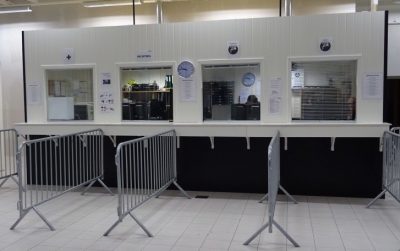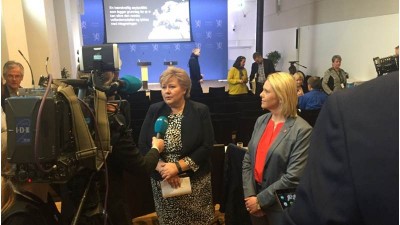Just two years after more than 30,000 refugees arrived in Norway, the country’s share of all asylum seekers in Europe has declined dramatically. Norway also ranks high in rejecting asylum seekers, and in forcibly sending them out of the country.

Only Bulgaria rejects more would-be refugees than Norway, according to new statistics from Eurostat, the official statistics service for the EU Commission. Newspaper Aftenposten reports that Norway has only received 0.3 percent of those arriving in Europe (defined as the EU/EEA countries plus Switzerland) and applying for asylum during the past 12 months. Norway earlier has taken in a much higher percentage of all asylum seekers arriving in Europe: 5.8 percent, for example, in 2009.
Norway’s current figure for asylum registrations is even lower than that for Denmark, which has historically had stricter immigration regulations than Norway. Only 3,525 asylum seekers have arrived in Norway during the past year, representing just 0.7 per 1,000 members of Norway’s total population. That compares to 2.1 in Europe as a whole.
The Eurostat figures show that Norway also has rejected fully 97 percent of the 1,885 adult men from Afghanistan who made their way to Norway and sought asylum. Norwegian officials still insist that many parts of Afghanistan are now safe and that the Afghan refugees don’t qualify for protection in Norway. Norway has also rejected 85 percent of asylum applications filed by men from Iraq.
‘Strictest asylum policies in Europe’
The high Norwegian rejection rate, along with Norway’s practice of sending rejected asylum seekers out of the country, has been challenged by authorities in France and elsewhere in Europe. Italian authorities, for example, processed 3,720 applications from adult Afghan men and rejected just 4 percent.
The numbers seem to confirm claims made just after the refugee influx by one of Norway’s most controversial government politicians, Sylvi Listhaug, that Norway would impose what she called “the strictest asylum policies in Europe.” Listhaug, from the conservative Progress Party, made the claim in December 2015 when she was named as Norway’s first minister of immigration and presented proposals for restricting it. Norway had, like the rest of Europe, just experienced an influx of refugees, mostly from the civil war in Syria and several countries in Africa. Listhaug took on the job of stemming the flow, and even though not all of her proposals succeeded, Eurostat’s numbers suggest she has succeeded. After taking in an average of 2,540 asylum seekers per month in 2015, Norway is now receiving around 375.

The sharp decline continues to set off complaints that Norway, one of the world’s wealthiest countries, is no longer taking in its fair share of refugees. While Italy and Greece struggle to care for thousands of refugees that have arrived by boat or been rescued at sea, arrivals in Norway have slowed to a trickle. That’s largely because of tighter border controls through the Balkan countries, in neighbouring Sweden and along the border Norway shares with Russia in the far north. Arrivals of asylum seekers in Europe also fell after EU officials struck a deal with Turkey to block refugees from moving beyond Turkish territory.
Aftenposten also reported on Thursday how refugee arrivals in Italy have declined dramatically in recent months as well, with only around 250 per day managing to sail to southern European shores from Libya. That compares to 7,150 per day in October 2015 and 930 as late as June. The reasons aren’t entirely clear, but the EU has tried various means of discouraging or preventing migrants from leaving Africa, while armed forces in Libya are preventing departures and holding migrants in camps under extremely difficult conditions.
‘Marshall Plan’ proposed for Africa
Norwegian Foreign Minister Børge Brende remains concerned that the refugee arrivals in recent years are still “only the tip of the iceberg.” He worries that the flow of refugees and migrants can “explode” once again, prompting him to propose a new sort of “Marshall Plan” for Africa that would send crisis aid to finance education and job creation much like the US’ Marshall Plan funding helped rebuild Europe after the devastation of World War II.
“If we don’t succeed at creating opportunities for the upcoming generation in Africa, the humanitarian crisis and migration will simply increase,” Brende told newspaper Dagens Næringsliv (DN) this week. He’s seeking international cooperation to improve the economic situation in areas around Europe. “It’s urgent,” Brende told DN. “There are more than a billion people in Africa today. In 2050 there will be nearly 2 billion. If children and youth don’t have a future there, it’s not just an African problem, it’s a huge problem for all of us.”
Norway, meanwhile, is settling more refugees than ever before and stressing integration programs. Listhaug, the immigration minister who’s part of a conservative coalition government running for re-election, wrote in an email to Aftenposten that she’s satisfied with the decline in arrivals of asylum seekers in Norway. Asylum, she claims, “is for those with a real need for protection,” not just a need to escape poverty. “If asylum seekers can live in safe areas of their homelands, they will be directed there instead of receiving asylum in Norway.”
newsinenglish.no/Nina Berglund

